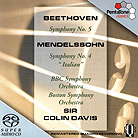April 2003
Though the Philips master tapes were apparently of superior quality, the main home delivery medium, vinyl LP, was incapable of adequately reproducing the sound they captured. SACD can do that with ease, however, so these masters can be widely heard for the first time as the performers and engineers intended. The results are astounding. Colin Davis has, in my opinion, become a boring and predictable conductor. But in the 1970s, he was young, brash, and alive; his readings usually struck many sparks and blended equal amounts of fire, energy, and lyricism. This Beethoven is a prime example of Davis’ art at the time. Recorded in 1974, it is bold and sharply detailed. The first movement is taken at just the right speed, the "fate" motif hammered out dramatically every time it appears. The second movement is exceptionally lyrical, with heroic interludes from the commanding brass section. The scherzo is exciting and buoyant, the quiet transition to the finale magnificently mysterious, the finale itself magisterial and dramatic without becoming bombastic. I somehow missed this recording when it first came out on LP, but now it has become one of my favorite versions. The Mendelssohn "Italian," recorded two years later in Boston, is a radiant, sunny reading, marred only by a first movement that seems just a tad slow, cautious, and earth bound. The PentaTone engineers, according to the liner notes, decided to leave the four-channel master as is, resisting any temptation to re-mix it to 5.1 -- "the idea behind this being to do full justice to the original intentions of both artists and recording technicians." What a noble and refreshing idea for today’s world of gussied-up re-masters: respect the original. The results prove that when you have four channels this good, you do not need more. Both recordings use the rear channels to re-create the natural ambience of each hall (Walthamstow Town Hall for the Beethoven; Symphony Hall in Boston for the Mendesslohn). Having the rear channels enabled produces to chronicle even better resolution and spatial relationships between sections of instruments. In the Beethoven, the listener is placed close up, about row 10 or closer. The sound is big, with an adequate stage depth, and ideal balances among strings, winds, and brass. The higher resolution of SACD allows each passage to be heard with every detail intact. The recording in Boston, which moves the listener back to row 20, is a little less successful. The tuttis tend to fold into the soundfield a bit, and the brass sometimes get lost at the back of the stage, rather than projecting from it. Having read several articles of the trials and tribulations RCA went through to record in this venue, I suspect the hall might be as much to blame as anything else might. Besides, these are fussy points in discussing a recording that is generally quite agreeable. Overall, the Beethoven is the best multichannel symphonic recording I have heard so far, besting anything 5.1, and the extra bits provided by the SACD format insure that I can listen to it all day without a trace of listener fatigue. It sounds good as a two-channel SACD, by the way, but kicking in those rears really makes it fly. The music making and engineering on this disc are of demonstration caliber. It is good news then, that PentaTone has seven other releases nearly as good, and promises to announce eight more by the time you read this. GO BACK TO: |
 Beethoven: Symphony No. 5
in C Minor
Beethoven: Symphony No. 5
in C Minor Surround sound is not that new. Before the recent DVD-Audio and SACD craze,
back in the 1970s, there were quadraphonic recordings -- four-channel discs that carried
left and right front information, as well as left and right rear channels. Sony and RCA
were at the forefront of the "quad" craze, but apparently, other companies, such
as Philips, were producing four-channel masters as well. Polyhymnia International (which
is how the Philips studio reorganized itself after Polygram "decommissioned" it)
has acquired the rights to release several of the Philips recordings on Hybrid SACD discs
under the PentaTone banner.
Surround sound is not that new. Before the recent DVD-Audio and SACD craze,
back in the 1970s, there were quadraphonic recordings -- four-channel discs that carried
left and right front information, as well as left and right rear channels. Sony and RCA
were at the forefront of the "quad" craze, but apparently, other companies, such
as Philips, were producing four-channel masters as well. Polyhymnia International (which
is how the Philips studio reorganized itself after Polygram "decommissioned" it)
has acquired the rights to release several of the Philips recordings on Hybrid SACD discs
under the PentaTone banner.